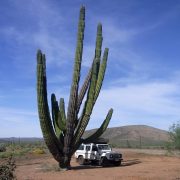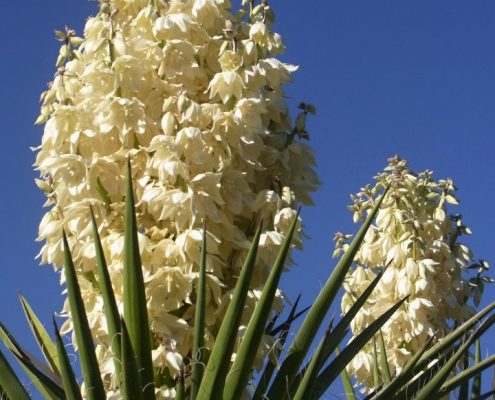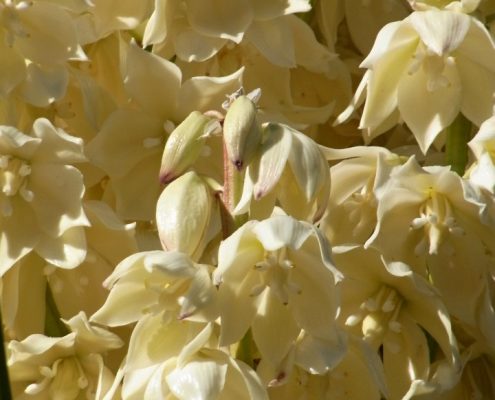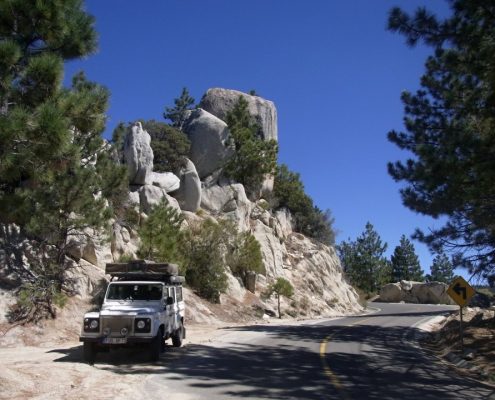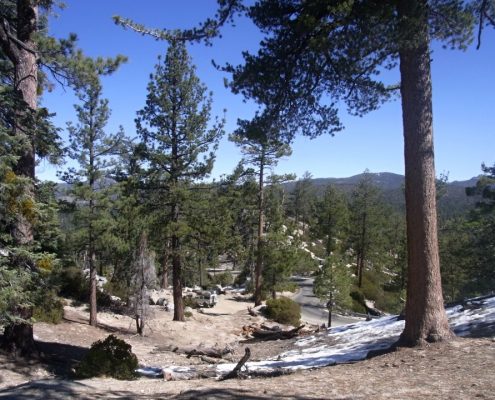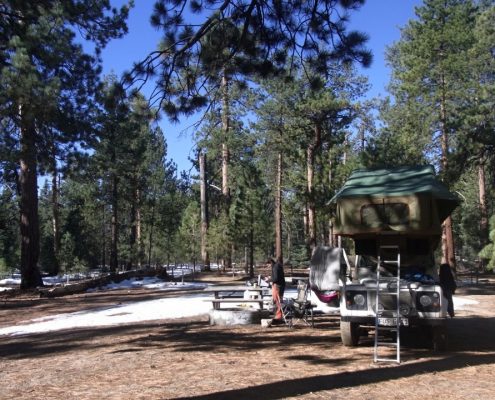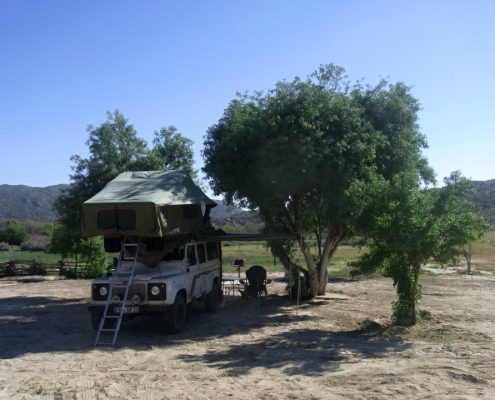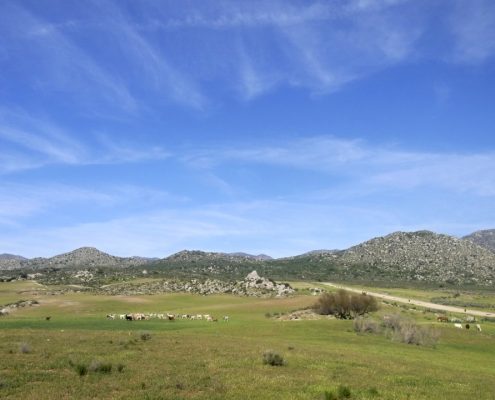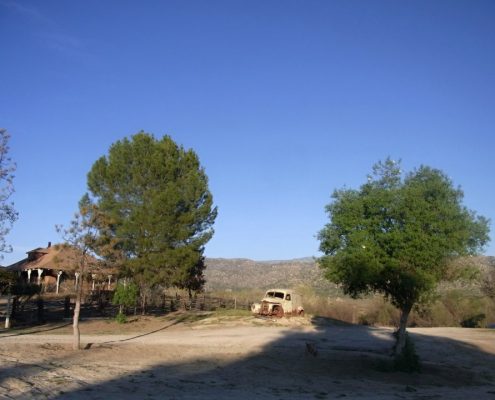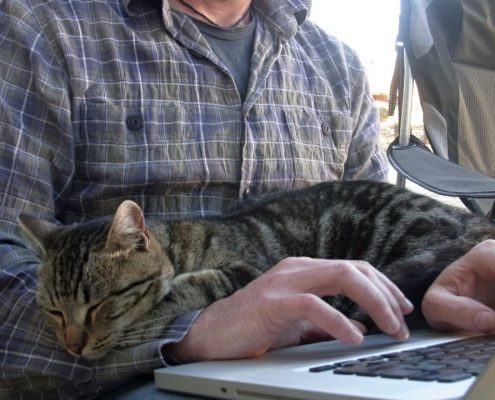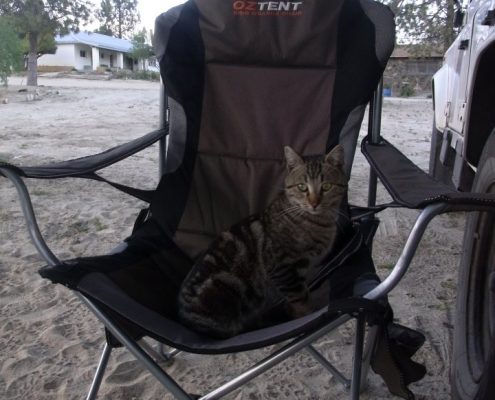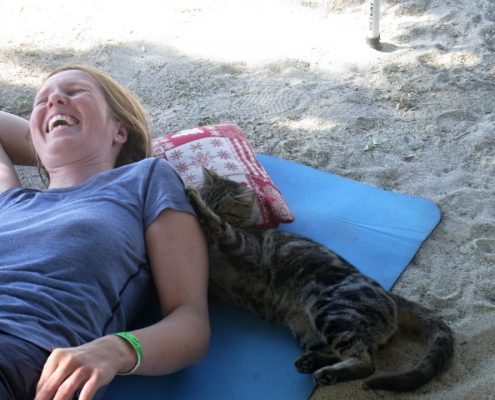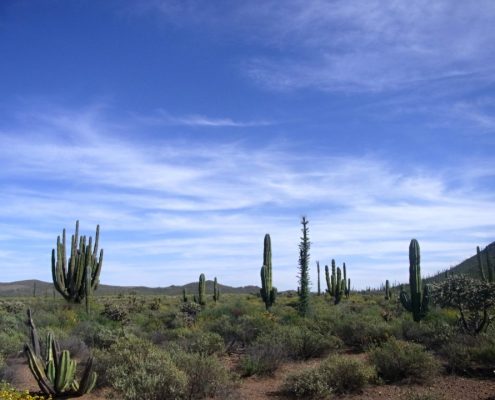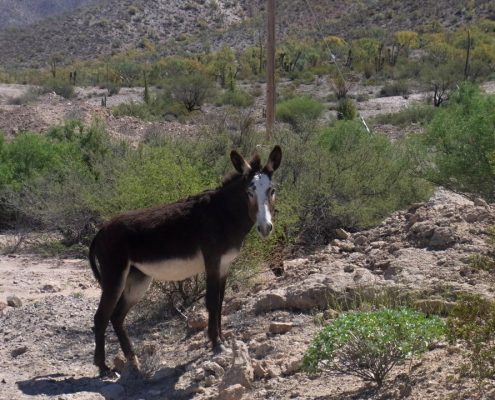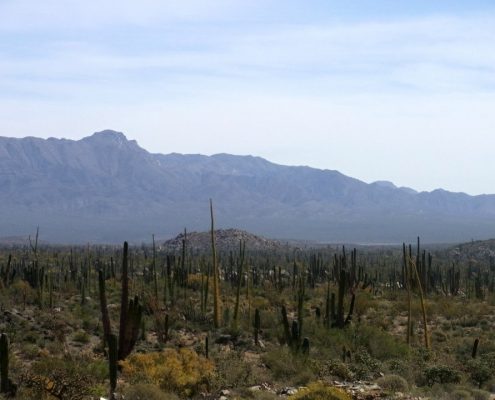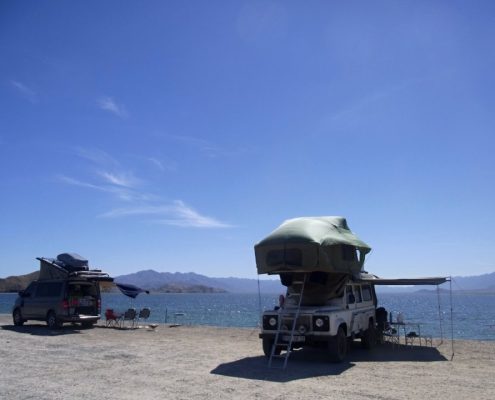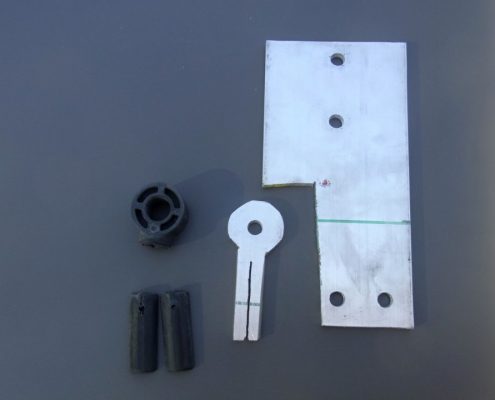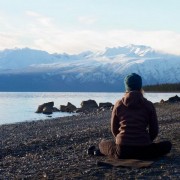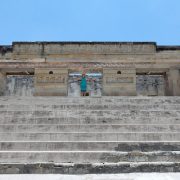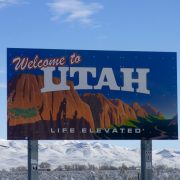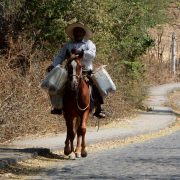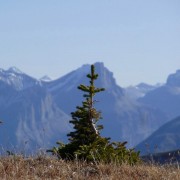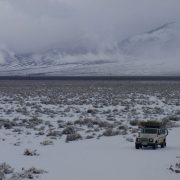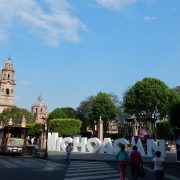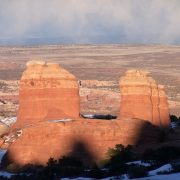Baja California North – Bienvenidos a Mexico
(26th February – 7th March, 2016)
When you plan to travel to Mexico it is not exactly the best idea to travel through the USA beforehand as the level of negative propaganda and fear mongering is unbelievable. Almost everyone, who we told that we were planning to go to Mexico, had the same series of emotions flicker across their faces. First wide eyed shock that quickly transformed to a look of horror and then settled on foreboding. From a well meant “be very careful” all the way to horrifying tales of “They will rob you of your car and leave you dead in the ditch!” We got the entire spectrum of warnings and horror stories all told from the perspective of “A friend of a friend” and besides everyone knows that Mexico is full of drug gangs, street thugs and violent criminals, right? And we want to go there? Per the opinion of the Americans we were being incredibly careless and taking an enormous risk for nothing. Though, interestingly enough, when meeting people who had actually, personally, being in Mexico (which was quiet seldom) we got a completely different story. They told us of an incredibly friendly and hospitable folk, awesome weather, wonderful beaches, noble colonial towns, and a passion for Mexican street food. Well, we were about to find out as for the second time we approached the Border, though not without a light feeling of trepidation.
Tecate Border Crossing
After once again passing the strange little border village on the US side we arrived at the actual border. I had to take care of some business on the US side before we could leave: Since there is no such thing as an exit stamp I had to return the visa card, that was stapled in my passport, to a border official before leaving the country. We looked around at the immigration area but couldn’t find where I needed to go; besides on this side of the border there only appeared to be an exit door. I asked a soldier if he knew where I needed to return the I-94 but they hadn’t heard of anything like that before. “No, you don’t need to return it”, they claimed. I was, however, of a different opinion especially after all the warnings I had read adamantly insisting that I give the visa back or I could have huge problems when or if we tried to re-enter the USA. So, I snuck in through the out-door and suddenly found myself standing in front of a rather overweight, puzzled border official. She too had no idea what I was talking about and neither did her colleagues. “So, then who do I give it to?” I asked her; after a moment pause she took the visa out of my hand, stuck it in her jacket pocket and walked off. Not exactly reassuring. Honestly, I have no idea if it will ever end up in the right hands or if I will be accused of being an Illegal immigrant sometime in the future.
That step completed we could finally enter onto Mexican soil. We passed a couple more soldiers who looked as though they wanted to wish us “good luck” or “god Speed”, we patently ignored them and passed the border barrier. The Mexicans greeted us with waves and smiles and pleasantly directed us to park behind the customs office until we had all the formalities taken care of. We desperately hoped that someone spoke English as our Spanish was almost nonexistent. Though we had bought a few Spanish books we were decidedly lazy when it actually came to learning anything. Gary made it all the way to chapter 2, but I was still stuck on chapter 1! So, our Spanish was limited to “Hello, Goodbye, thank you and please” and of course the odd tourist phrase and perhaps a word or two we picked up somewhere – not exactly enough to complete any complicated border crossings. Though thankfully we didn’t need any of our pathetic Spanish knowledge as we were immediately greeted in English by the Migracion officer who was obviously used to having to deal with Gringos. The paperwork was also thankfully provided in both English and Spanish so that didn’t end up being the challenge we were so worried about. After paying the visa fees at the nearby bank we moved over to Customs to deal with the temporary import of our vehicle. At customs we had to pay some more and provide all manner of photocopies that we had to have made around the corner from the Customs office at a small Pharmacy. They took a quick look at our vehicle and after only 1 ½ hours we were done. Uncomplicated and friendly with wishes for a great trip and a few tips of what to see along the way. That was really easy! Especially after all the stories about complicated bureaucracy and hours upon hours of wait times we were pleasantly surprised at how easy it ended up being.
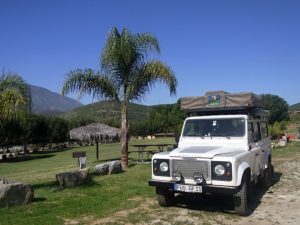 The First Day in Mexico – Everything is Different
The First Day in Mexico – Everything is Different
Just across the border and suddenly everything was different! There wasn’t any type of gradual change over zone (like we kind of expected), but rather one dove right into the deep end from one world into a completely different one altogether. Just a moment ago, everything was orderly, signposted, calm and clean and then BAM! Chaos. The border town of Tecate is decidedly hideous with a mixture of shanties and half finished “houses”. It was overrun with people and cars (at least for us as we had spent months in the quiet empty wilderness), the driving style was a factor or two more aggressive than what we were used to and they obviously forgot to budget for road signs. Although, it was quite balmy we drove around with the windows up and locked the doors. We were rather insecure having just arrived and decided to stick to the security advice we had previously received, however exaggerated it may have been. Since we had decided to leave the border zone as quickly as possible (supposedly that’s where most of the problems are – and we hadn’t only heard that from the US-Americans), we wanted to head for Ensenada by the most direct route. At first, we followed what signs we could find for the MEX 3 before suddenly coming to the end of the road and a construction site. “Did we miss the detour sign? Was there a detour sign?”, we asked ourselves. Apparently not. The cars behind us started to pull out and pass on the oncoming lane. “But, they aren’t allowed to do that” I called out. “Yeah, but they’re doing it anyway” said Gary before pulling out and following the others on the wrong side of the road. A bit of nerve wreaking driving more and we were finally out of town where I released the breath that I hadn’t realize I had been holding.
The landscape along the MEX 3 was filled with green hills and poor looking villages where we passed mostly ramshackle bungalows and shacks. Almost everywhere we looked the windows and doors were barred; the roadsides filled with trash told a sad tale of poverty and neglect. The occasional noble wine villa provided a stark contrast to the hopelessly poor huts that dominated the landscape. We drove in silence as we took in the huge gap between the super-rich and the destitute; it had never been so painfully obvious, especially for me since I had never been in a comparable country before.
After about 2 hours we reached the town of Ensenada on the Pacific and turned from the MEX 3 onto the 1, which would lead us for almost 1000 km to the very south of the Baja peninsula. We passed through the lively city-center of Ensenada, greeted the Pacific Ocean once again and headed onwards passing first through the poor neighborhoods with their unfinished, half demolished, barred or boarded windows and garbage filled little alleyways. It was all a little scary. Could the Americans have been right with their warning in the end?
About 20 km south of Ensenada we stumbled upon our first camping spot – An amusement/nature park where one can also camp. The grounds looked really well maintained (it also had a huge fence, which for our first night gave us a sense of security), so we didn’t think about it all too long. The guard was quite friendly enough to punch the sum into a calculator as with our non-existent Spanish we had no idea what he had said: 150 Pesos ($15 USD) and we could use the whole park (with the exception of the rides) including hot showers and WiFi! Being used to the prices in the USA we thought it was incredibly cheap – though of course we had no idea what awaited us. We set up our camp next to a nice field with a picnic table and treated ourselves to a nice cold Cola from the little Kiosk at the park entrance. A little sensory overloaded from the day we had to just sit a quiet moment or two to take it all in. We survived our first day in Mexico and even managed to find a safe spot to camp for the night with showers! When that wasn’t a success! Actually, we had the feeling that our adventure had really only just begun.
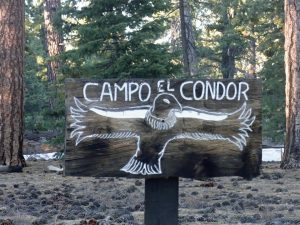 Sierra de San Pedro Martir National Park
Sierra de San Pedro Martir National Park
On our second day, the first Mexican highlight waited for us: Sierra de San Pedro Matir National Park – home to the rare California Condor, amongst many others. On our way there, we had the opportunity to get used to the quality of the roads. Despite being the main artery to the south the MEX 1 is relatively narrow, there isn’t a shoulder and the surface changes without any warning from good to bad with huge pot-holes. The signage also leaves something to be desired; where in Canada and the USA every attraction was announced miles in advance in Mexico that was sadly at an end. If you were lucky there was a sign directly at the turn off, mostly though it was either somewhere along the way or not at all.
The road to the park was a wonderfully small and lonely road that lead sinuously over the 100 kms from sea-level upwards to almost 2500 meters. The views got better and better the higher up we drove and the vegetation changed with the increasing altitude. We passed Yucca palms in bloom and all manner of strange unknown flora before finally reaching a high Pine forest. At that altitude, it was much cooler and we even saw large patches of snow in amongst the trees and along the side of the road! In the small hut at the park entrance the Park ranger showed us where to enter our names in the guest book and collected the 60 Pesos ($3 USD) entrance fee, camping was free! We were rather curious as to what awaited us and were surprised to find that a real off-road trail led us through the forest to the camping spots – just what we liked. What we didn’t like was seeing all the garbage that was lying all over the place. Unfortunately, they only have open garbage bins where only organic waste is to be deposited and despite all the signs saying to take your non-organic garbage with you, apparently everyone seemed to ignore them. In every bin we found plastic cups, Styrofoam plates, plastic bags, bottles, and every other conceivable non-organic waste from the last BBQ. All that would then be picked through by the Condors, Buzzards, Crows/Ravens, and other animals on the lookout for something edible and then spread rather dynamically throughout the surrounding forest. We set up our camp between the massive Pine trees and unpacked our winter clothes once more as with sunset the temperatures dropped dramatically. With the thought of a camp fire we soon realized we had no idea what the word for wood was in Spanish, so with dictionary in hand we headed to the Ranger hut to see about getting some wood. On the way we almost stumbled into a Coyote coming the other direction along the path. It stopped not 10 meters from us and watched us calmly as we watched it. They are remarkably striking creatures with thick gray brown fur and bushy tails, not anything like the mangy creatures we are lead to believe they are. We stood rooted to the spot simply watching the coyote watching us before the spell was broken and it turned and loped into the deeper forest. Cursing ourselves for not having a camera with us that magical meeting would have to go without a photo. At the Ranger station, we asked for wood, “Leña?” Apparently, we had found the right word (though I am quite sure the pronunciation was way off) as he smiled and with hand gestures informed us that we just needed to collect downed and dead wood to burn. Still used to the rather strict rules of the National Parks in the rest of North America we didn’t want to risk it without first asking. A short time later we huddled close to our crackling little fire for warmth. Later in the evening we learned firsthand how much Mexicans like to party. Not too far away from us a group of locals had set up their tent and soon thereafter the boom box started blasting out Latin American party music throughout the forest. Apparently, the quiet enjoyment of Nature is not exactly something the Mexicans come by naturally. However, the party only lasted until around 11 pm after which the natural music of the forest could once again be heard.
Rays of sunshine warmed us at our picnic table the next morning as we enjoyed a wonderful breakfast under the huge pine trees then packing up and driving to the end of the park, visiting several lookouts along the way before heading for the exit.
Vacation at Rancho Meling
On the way back we stopped at the oldest ranch on Baja California – Rancho Meling – and were thrilled to find a wonderful little campground surrounded by grassy hills and far away from the next village or town. A little paradise! We immediately decided to spend a few days and set up our camp with a spectacular panorama and enjoyed the afternoon sun. At the ranch, we learned the next important rule of Mexico: Always have enough toilet paper, regardless of where you are as there isn’t any available in most toilets. There was some mention of that in a book somewhere but we had never the less forgotten about it and there we were with what looked like not enough to last a day let alone a few days. Thankfully the ranch had some in their mini-market. Going to the toilet in Mexico also took some getting used to as it is quite a bit different: Instead of throwing the used paper into the toilet you throw it into the waste basket (apparently, this is to prevent the poorly designed/made lines from clogging). Though, It wasn’t only a matter of adapting our toilet behavior we also had to adapt to the idea of sitting beside a bin filled with the used bits of paper from the previous visitors.
At the ranch, we finally did something that we had been wanting to do for a long time: Horseback riding! We thought about riding in Canadas Western provinces but that was sadly way out of our budget. Here though that didn’t really factor into it so we took the opportunity to hop on a couple of ponies in the early morning with our guide, who thankfully spoke some English, to tour through the hilly landscape surrounding the Ranch.
Beside horses there were cows, chickens, dogs and cats on the ranch and it was nice to finally have so many animals around. We even had our own “pet” as a small cat decided to hang out with us. He came by every morning for a visit and made himself right at home on our camp chairs for a snooze, inspected our vehicle and even hopped into our laps for a some loving. It was a little hard leaving the little guy behind when we broke camp after our 3 days on the ranch.
First Shopping Experience in Mexico
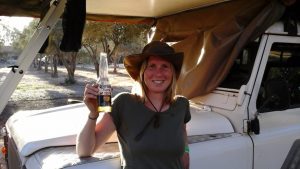 Our supplies were almost gone after our stay at Rancho Meling and so at the next larger town, San Quintin, we wanted to stock up on all the necessities, at least that’s what we had planned. The seedy little town had just the main dusty thoroughfare straight down the middle. Left and right along the entire stretch of road were more or less dodgy looking tiendas (shops), street kitchens and food stalls. Shopping started with wanting to buy water, normally we would have just gotten it from a tap somewhere – in the USA and Canada you can be sure that it is Potable – here however we were warned against that practice. Just like the locals we also had to buy our drinking water. There were two options: you either buy bottled water from the supermarkets, or you buy it from a “Purificadora”, which is a lot cheaper. Since we had seen two or three along the road we decided to go with the cheaper variation, though we were a bit unsure how “pure” it was or whether they adhered to some kind of hygiene standards if at all. We simply had no idea. Though, we saw enough locals coming and going from the fill stations with their empty bottles full to assuage our fears. As we finally handed our two containers over the counter we were pleasantly surprised: Everything was spotlessly clean and the guy on the other side of the counter was even wearing a mask over his mouth! The question about where to get our drinking water was solved. The next shopping question – groceries – had yet to be answered. The whole time we had imagined how the isles would be filled to overflowing with all manner of fresh exotic fruits and veggies, after all the grocery stores in Canada and the USA have all kinds of imported produce from Mexico so we figured we should be able to buy all of that here for much cheaper. Though as we finally stood in front of the fresh food section looking upon a few wizened green peppers, onions, limp celery and yellowed broccoli we were rudely awoken to the harsh light of reality. The fruit section was just as sad looking: Juice oranges, limes, imported navel oranges and a few wrinkled apples – and that’s it! But on the way we had passed huge strawberry fields, but apparently it was all for export, with the only the 2nd class or worse left for the local markets. There was everything one needs to survive, though the produce was just depressing. With that sobering experience we decided to try our luck elsewhere, there was another supermarket down the road that looked a bit more “local”. Since there wasn’t a parking lot and folks just parked every which way Gary decided it would be more prudent to stay with the car. This time it was truly a Mexican experience: There was no real floor in the supermarket just a layer of dirt. The shelves were packed with boxes and bags and surprisingly the produce was much better, when not exceptional, and a heck of a lot cheaper. Since I was the only tourist present I was being stared at unashamedly. They were all very friendly and helpful, handing me a plastic bag to put my veggies in and smiles all around. I made a huge detour past the meat counter though, as buying meat is another experience all together. We are quite honestly spoiled with buying meat a bit farther north or in Germany as it is a very clean experience. Cleanly cut, appetizingly arranged and almost neutral in smell. Here, however, you can smell the meat counter from far out and it doesn’t smell like yummy smoked meats, it smells like a slaughter house and not exactly fresh entrails. Coming closer one sees huge piles of pork, beef, chicken, stomach, sausages, and all manner of identifiable and nonidentifiable piles of stuff. The smell alone was enough to spoil the appetite for meat and since we don’t eat all that much of it anyway perhaps it was best not to risk buying any, at least in the interim. Not like the Mexicans though; the longest lines were always in front of the meat counter where huge portions of meat crossed the counter to end up in their wagons. With produce in hand we decided that we had enough adventure for one day and set up camp at a nearby campground ending the day with a couple of nice cold Coronas.
Our supplies were almost gone after our stay at Rancho Meling and so at the next larger town, San Quintin, we wanted to stock up on all the necessities, at least that’s what we had planned. The seedy little town had just the main dusty thoroughfare straight down the middle. Left and right along the entire stretch of road were more or less dodgy looking tiendas (shops), street kitchens and food stalls. Shopping started with wanting to buy water, normally we would have just gotten it from a tap somewhere – in the USA and Canada you can be sure that it is Potable – here however we were warned against that practice. Just like the locals we also had to buy our drinking water. There were two options: you either buy bottled water from the supermarkets, or you buy it from a “Purificadora”, which is a lot cheaper. Since we had seen two or three along the road we decided to go with the cheaper variation, though we were a bit unsure how “pure” it was or whether they adhered to some kind of hygiene standards if at all. We simply had no idea. Though, we saw enough locals coming and going from the fill stations with their empty bottles full to assuage our fears. As we finally handed our two containers over the counter we were pleasantly surprised: Everything was spotlessly clean and the guy on the other side of the counter was even wearing a mask over his mouth! The question about where to get our drinking water was solved. The next shopping question – groceries – had yet to be answered. The whole time we had imagined how the isles would be filled to overflowing with all manner of fresh exotic fruits and veggies, after all the grocery stores in Canada and the USA have all kinds of imported produce from Mexico so we figured we should be able to buy all of that here for much cheaper. Though as we finally stood in front of the fresh food section looking upon a few wizened green peppers, onions, limp celery and yellowed broccoli we were rudely awoken to the harsh light of reality. The fruit section was just as sad looking: Juice oranges, limes, imported navel oranges and a few wrinkled apples – and that’s it! But on the way we had passed huge strawberry fields, but apparently it was all for export, with the only the 2nd class or worse left for the local markets. There was everything one needs to survive, though the produce was just depressing. With that sobering experience we decided to try our luck elsewhere, there was another supermarket down the road that looked a bit more “local”. Since there wasn’t a parking lot and folks just parked every which way Gary decided it would be more prudent to stay with the car. This time it was truly a Mexican experience: There was no real floor in the supermarket just a layer of dirt. The shelves were packed with boxes and bags and surprisingly the produce was much better, when not exceptional, and a heck of a lot cheaper. Since I was the only tourist present I was being stared at unashamedly. They were all very friendly and helpful, handing me a plastic bag to put my veggies in and smiles all around. I made a huge detour past the meat counter though, as buying meat is another experience all together. We are quite honestly spoiled with buying meat a bit farther north or in Germany as it is a very clean experience. Cleanly cut, appetizingly arranged and almost neutral in smell. Here, however, you can smell the meat counter from far out and it doesn’t smell like yummy smoked meats, it smells like a slaughter house and not exactly fresh entrails. Coming closer one sees huge piles of pork, beef, chicken, stomach, sausages, and all manner of identifiable and nonidentifiable piles of stuff. The smell alone was enough to spoil the appetite for meat and since we don’t eat all that much of it anyway perhaps it was best not to risk buying any, at least in the interim. Not like the Mexicans though; the longest lines were always in front of the meat counter where huge portions of meat crossed the counter to end up in their wagons. With produce in hand we decided that we had enough adventure for one day and set up camp at a nearby campground ending the day with a couple of nice cold Coronas.
Bahia de Los Angeles
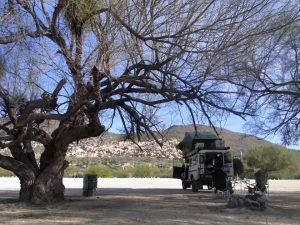 Leaving San Quintin we headed for the first time to the other side of the peninsula to the Sea of Cortez, which separates the Baja from the main land. Our destination was the little village of Bahia de Los Angeles. The road led us through a desert landscape where we saw the largest cacti that we had ever seen; it was also definitely a lot hotter than we were used to. We soon passed the first of many military checkpoints that we would have to cross every couple of hundred KM going south. The whole thing was a bit scary, I had never been through a military checkpoint before. The obvious military presence with their machine guns, vehicles and soldiers would take a bit of getting used to, especially as they stood there directly next to the Landy. Though mostly they weren’t interested in us. Every now and then they wanted to peek in the car, but only for a quick look before they let us drive on.
Leaving San Quintin we headed for the first time to the other side of the peninsula to the Sea of Cortez, which separates the Baja from the main land. Our destination was the little village of Bahia de Los Angeles. The road led us through a desert landscape where we saw the largest cacti that we had ever seen; it was also definitely a lot hotter than we were used to. We soon passed the first of many military checkpoints that we would have to cross every couple of hundred KM going south. The whole thing was a bit scary, I had never been through a military checkpoint before. The obvious military presence with their machine guns, vehicles and soldiers would take a bit of getting used to, especially as they stood there directly next to the Landy. Though mostly they weren’t interested in us. Every now and then they wanted to peek in the car, but only for a quick look before they let us drive on.
That afternoon in Bahia de Los Angeles we had a pleasant surprise as Ingo, Elvira and Perla arrived at the same campground! We certainly didn’t expect to see them again so soon as they had gone in the other direction the last we had seen them. The next day we all drove to a different camping area just a few kms out of town called La Gringa, the most northerly point of the bay where the camping is free. The view was also much better than our previous spot. The village of Bahia doesn’t offer too much in the way of fresh produce and is quite ugly to boot. We learned quite quickly though, that it is best to buy produce at the market, at roadside stalls or directly from a mobile shop in the form of a laden pickup. Though in the north of Baja a rarity too so we no longer thought about what we would like to cook but more cooked with what we could find.
At La Gringa we spent a few relaxing days, going for walks along the beach, baking bread with the excellent Mexican charcoal and, for the first time witnessed something extraordinary: Bioluminescent plankton! At first we thought it was the reflection of the stars above or some other light source though we soon realized that the water only glittered when it moved. Excited and fascinated, we splashed around with our hands in the water causing the plankton to glitter and glow. Every evening thereafter we walked to the waters edge to watch the sparkling produced by the tiny waves or whitecaps. After two days of wonderful weather a front began to move in and within a few hours we found ourselves in the middle of a wind storm. The wind shook and pulled at our tent making it almost impossible to sleep and during the day we all took refuge under our Foxwing where we had added 3 walls and staked everything down as much as possible. However, the wind blew so hard that we feared it would break something and so we decided to pack everything away and sleep in the car – a difficult task, as it is not advisable or safe to try to pack the Foxwing away in the middle of a storm. With two extra helpers holding it at the supports we folded one section after the other as carefully as possible, unfortunately not carefully enough. A loud crack signaled the worst case, one of the arms broke at the main hinge – shit, that was exactly what we had feared! Thankfully Ingo is a real handyman and had enough tools with him to open his own garage, though at that moment we couldn’t do anything about it so fled into our respective cars to wait out the storm.The next morning, we inspected the joint a little more closely and with help and material from Ingo we managed to MacGyver a new joint that was almost better than the original!
With the repairs completed we thought it was time to move on southward, though we arranged to meet up in Southern Baja at Guerrero Negro to go whale watching together. Something that we had been looking forward to for a very long time! Onward to Southern Baja.
More Photos on Flickr: Northern Baja

